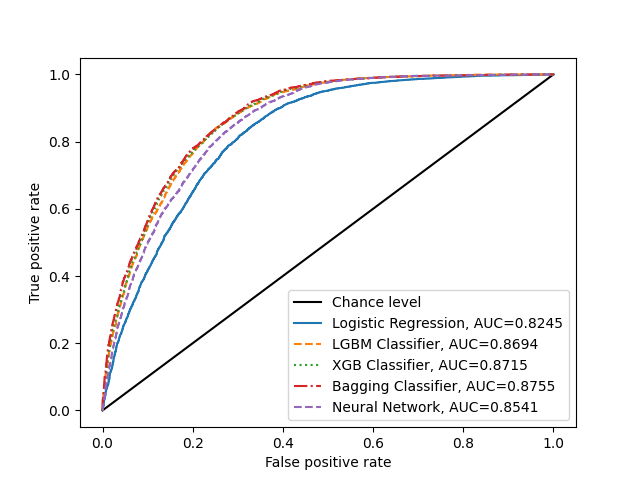The notebook main.ipynb tackles Kaggle's Smoker Status Prediction challenge. It is structured into explorative data analysis, feature engineering, modeling and results.
The training dataset comprises the following 24 variables:
id: Unique identifier for each data point.age: Age of the individual, categorized in 5-year intervals.height(cm): Height of the individual in centimeters.weight(kg): Weight of the individual in kilograms.waist(cm): Waist circumference of the individual in centimeters.eyesight(left/right): Eyesight measurements for the left and right eyes.hearing(left/right): Hearing ability for the left and right ears, represented as binary.systolic: Systolic blood pressure measurement.relaxation: Diastolic blood pressure measurement.fasting blood sugar: Fasting blood sugar level.Cholesterol: Total cholesterol level.triglyceride: Triglyceride level.HDL: High-density lipoprotein cholesterol level.LDL: Low-density lipoprotein cholesterol level.hemoglobin: Hemoglobin level in the blood.Urine protein: Level of protein in urine, categorized.serum creatinine: Serum creatinine level.AST: Level of aspartate aminotransferase enzyme.ALT: Level of alanine aminotransferase enzyme.Gtp: Level of gamma-glutamyl transferase enzyme.dental caries: Presence (1) or absence (0) of dental cavities.smoking: Target variable indicating if the individual is a smoker (1) or not (0). Not present in the test set but can be evaluated on Kaggle.
The different classifiers evaluated on Kaggle's private dataset:
| Classifier | Result on Kaggle (AUC) |
|---|---|
| Logistic Regression | 0.825 |
| LGBM | 0.874 |
| XGB | 0.873 |
| Bagging (XGB) | 0.875 |
| NN | 0.854 |
Below graph shows the AUC scores of the different classifiers evaluated on own test sets of the public dataset. Note that for the logistic regression barely any parameters are set to have a simple baseline. Further, feature engineering still has some room for improvements which would likely increase performance.
